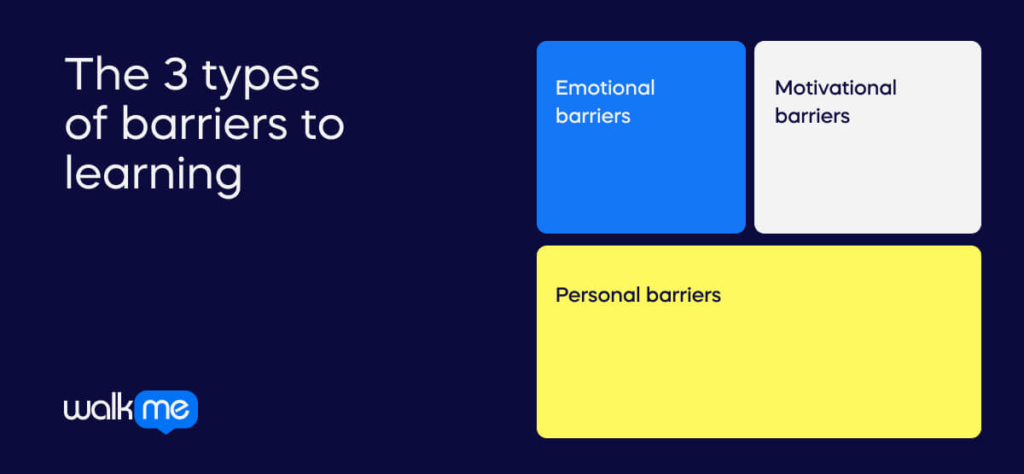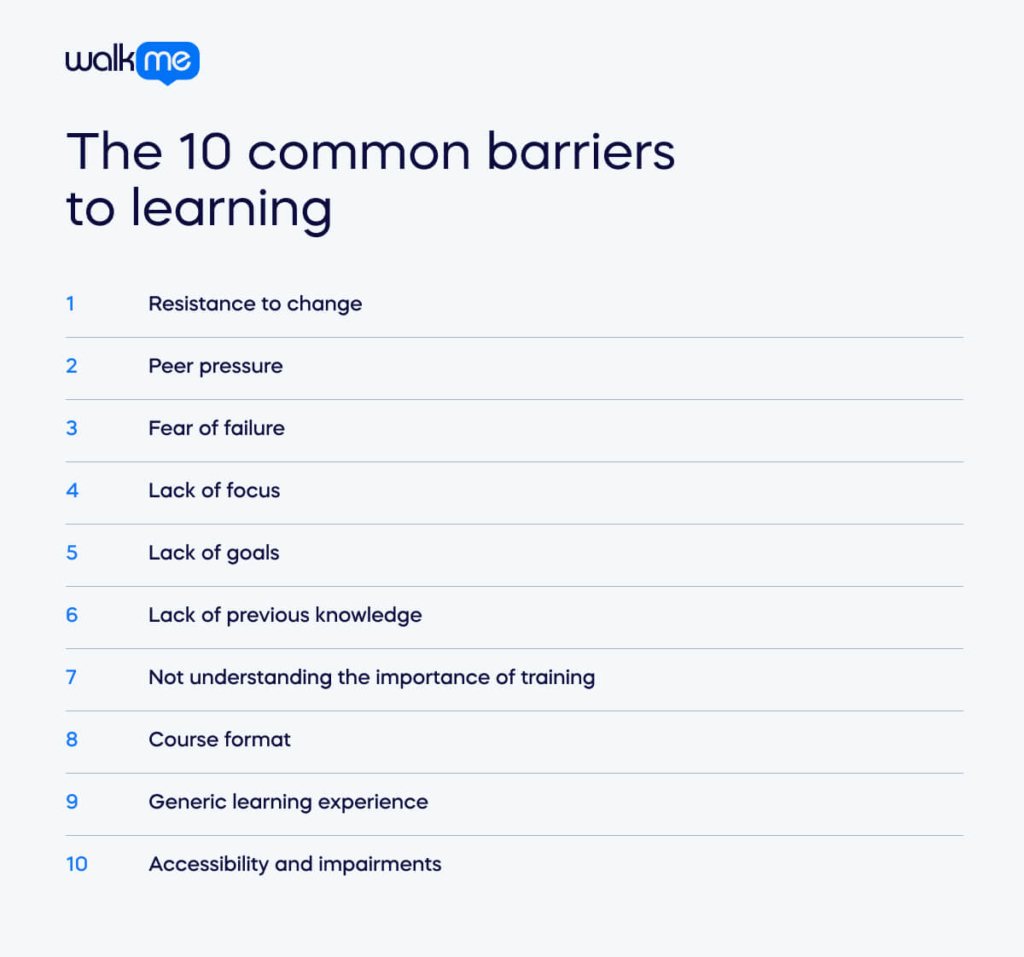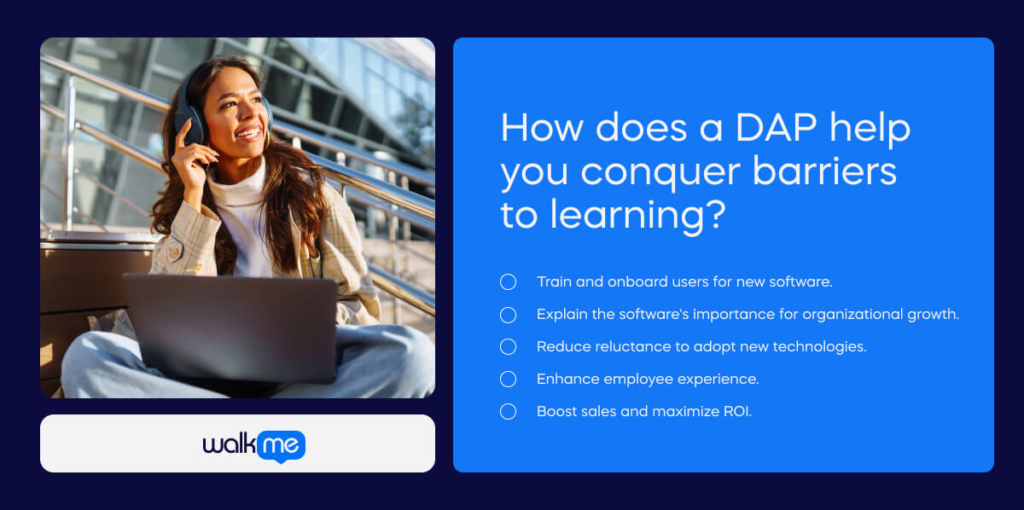You give your staff everything they need to learn and develop, but they still don’t grow as they should. What are you doing wrong?
There are several reasons why staff struggle to learn, upskill and reskill.
You must tackle these barriers to learning to optimize the use of every staff member and retain them.
Doing so will make you part of the 69% of companies that have increased employee training and development in recent years.
To help you understand the 10 barriers to learning and conquer them, we will explore the following topics:
- What are the 3 types of barriers to learning?
- What are the ten barriers to learning?
- How do you conquer the barriers to learning?
What are the 3 types of barriers to learning?

There are three types of barriers to learning: Emotional, motivational, and personal. Knowing the common learning barriers will help you conquer each to ensure successful digital transformation.
1. Emotional barriers
Emotional barriers to learning are found deep within a person’s mind, often negatively impacting their learning process. Emotional learning barriers come from fears and doubts about your ability to learn new skills or business processes.
Emotional barrier examples include:
- Resistance to change.
- Fear of failure.
- Peer pressure.
- Lack of focus.
2. Motivational barriers
As adults, we have lost the desire and curiosity to learn that we used to value so highly when we were children.
As a result, we need a clear incentive to convince us that a learning experience is worthwhile for us, representing motivational barriers.
These barriers become visible when staff miss training sessions or lack interest in personal development.
Motivational barrier examples include:
- Lack of previous knowledge.
- Failing to grasp the importance of the training.
- Lack of clear goals.
3. Personal barriers
The final type of learning barrier is the personal barrier, which involves the personal learning process for each person and their way of learning.
Personal learning barriers include:
- Different learning styles: Individuals have varying strengths in processing and retaining information in their employee learning journey. Some excel in visualizing and remembering data, while others rely on their numerical or auditory faculties to memorize information.
- Physical or neurological impairment: For example, when someone faces challenges with hearing, speaking, or vision, it is crucial to adapt the learning process accordingly and discover alternative, more effective ways to convey your message.
It is helpful to be aware of these types of barriers to learning to support your staff to conquer them all, unlocking their learning potential so they can continuously develop, improve processes, and help your organization thrive.
What are the ten common barriers to learning?

There are ten barriers to learning, and it is essential to be aware of them to optimize your staff’s learning process.
- Resistance to change
- Peer pressure
- Fear of failure
- Lack of focus
- Lack of goals
- Lack of previous knowledge
- Not understanding the importance of training
- Course format
- Generic learning experience
- Accessibility and impairments
1. Resistance to change
Type of barrier: Emotional
Resistance to change is the first emotional learning barrier we’re going to discuss – it was something we saw as companies moved to work-from-home setups, with employees refusing to adopt necessary online processes and tools critical for remote work.
How to overcome the resistance to change barrier to learning:
Encouraging your staff to step out of their comfort zones and embrace new opportunities for upskilling and cross-skilling is crucial for overcoming resistance to change.
By understanding the importance of this mindset shift, your team can effectively adapt and thrive in a constantly evolving environment. Give it a try!
- Presenting compelling statistics, tangible results, and concrete evidence that the new approach is unequivocally superior in accomplishing objectives.
- Assisting your employees during the transition phase.
- Ensuring ample onboarding resources and tutorials facilitates seamless adaptation and navigation of new tools.
2. Peer pressure
Type of barrier: Emotional
Peer pressure can act as an emotional obstacle to learning, resembling a form of adult bullying.
This issue commonly arises within the workplace when senior management insists that lower-ranking staff participate in mandatory courses or training without adequately explaining the practicality or advantages to the employees involved.
Employees may also face peer pressure to attend training sessions they are not required to, simply to avoid feeling excluded.
How to overcome the peer pressure barrier to learning:
Overcoming peer pressure can be challenging, just like many other social barriers. To create a peer-pressure-free workplace, consider these helpful tips:
- Survey your employees for valuable insights on this course’s learning objectives and desired outcomes. Their input will provide crucial guidance and help shape the course to meet their needs effectively.
- Ask them about their reasons for enrolling in the training program.
- Explain the course’s significance across different job roles, emphasizing its relevance to various professions.
- Make the training voluntary and customized to cater to individual requirements.
3. Fear of failure
Type of barrier: Emotional
The fear of failure is a profound emotional obstacle to learning, often originating from an unresolved or unpleasant experience from the person’s past. In this scenario, the learner can become overwhelmed by self-doubt and firmly believe they cannot comprehend new information or acquire new skills.
Frequently, individuals seek refuge in their areas of expertise, inadvertently depriving themselves of the opportunity to acquire new knowledge or explore alternative career paths.
They may hesitate to step outside their zone, driven by fear of the unfamiliar and the fear of failing.
How to overcome the fear of failure learning barrier
To support employees who struggle with fear of failure and self-consciousness, shifting their focus away from the stakes is crucial. Instead, aim to create an enjoyable and engaging process that replaces fear with a sense of excitement and enthusiasm.
Doing so can foster a more positive and productive environment for everyone involved. For example:
- Incorporate gamification into your training sessions by introducing certificates or contests to add an enjoyable twist.
- It is important to reassure employees that making mistakes during the learning or “test” period is typical and even expected.
- Remain accessible to provide support and address any potential queries that may arise.
4. Lack of focus
Type of barrier: Emotional
Learning in the workplace can be challenging when maintaining focus and finding an interruption-free environment.
How to overcome the lack of focus learning barrier
If lack of focus is what you’re dealing with, here are some tips to try:
- Ensure you have a serene and private space dedicated to your training sessions. This area should be devoid of any disturbances or interruptions caused by coworkers.
- Plan training sessions beforehand and reserve specific time slots in your employees’ schedules.
- Utilize a diverse range of course formats and learning methods. We strongly encourage the exploration of VARK’s multimodal learning model.
5. Lack of goals
Type of barrier: Motivational
Motivating and engaging employees is a vital component of successful L&D strategies. One widely employed technique is the implementation of SMART goals.
Without goals, procrastination takes hold. However, with clear goals in place, motivation and productivity soar.
How to overcome the lack of goals learning barrier
Establishing precise and attainable goals is crucial to prevent employee unproductivity and lack of motivation.
The development team is crucial in efficiently scaling and growing your business.
If you’re uncertain about the clarity of your business and individual goals, consider asking yourself the following questions:
- What metrics can I use to gauge the progress and completion of the process (KPIs)?
- What additional skill should the employee acquire as a result of this training?
- How can this skill be effectively integrated into the workplace?
- What advantages does this course offer to the employee?
6. Lack of previous knowledge
Type of barrier: Motivational
A lack of prior knowledge can be a demotivating hurdle, causing individuals to lose their drive to learn.
A lack of knowledge is prevalent when employees seek to transition careers or acquire new skills from scratch. In such situations, learners often feel overwhelmed and disoriented, making it challenging to envision comprehending the subject matter.
How to overcome the lack of previous knowledge learning barrier
To avoid the loss of learning motivation resulting from a lack of prior knowledge, consider implementing these strategies:
- Inform the employee that your expectations are minimal and they can work at their rhythm.
- Offer reassurance that the learning process unfolds in stages, assuring them that soon they will grasp the underlying logic.
- Explore real-time ways to provide incentives or rewards for accomplishments to enhance motivation.
7. Not understanding the importance of training
Type of barrier: Motivational
Implementing numerous employee engagement ideas to enhance staff interest in training will not yield results unless they grasp its importance. Emphasize the necessity for their presence and acquisition of new skills.
However, what motivates them to do so? What benefits do they stand to gain? Recognizing the significance of training and upskilling is vital to ensure your staff’s optimal performance and utilization of their capabilities.
How to overcome the importance of training learning barrier
To effectively convey the significance of a course or training, consider the following guidelines:
- Demonstrate in practice the abilities they will acquire upon completing the course.
- Provide a course outline with the main topics the course will cover.
- Establish a direct correlation between the training and tangible workplace outcomes and enhancements.
8. Course format
Type of barrier: Personal
Another personal barrier to consider is the course format or training, which refers to the method you use to convey information effectively.
The format encompasses various mediums such as videos, webinars, slide presentations, images, graphs, process documentation, flowcharts, and online learning. Take this into account when crafting training materials.
How to overcome the course format learning barrier
Below are some valuable recommendations to assist you in enhancing the format and design of your course, creating a more enjoyable and practical learning experience for your employees:
- Survey your staff to learn their preferred methods of acquiring new knowledge.
- Designing the course or training to encourage interaction or gamification is essential to maintain engagement.
- To effectively convey information, consider presenting it in various formats. For example, you can utilize both tables and graphs for numerical data.
- It is crucial to balance theory and practice to ensure comprehension and effective implementation of your teachings.
9. Generic learning experience
Type of barrier: Personal
Each person possesses a unique learning style and skills to process information and data in a learning environment.
Consequently, learning encounters lacking personalization prove unhelpful and yield diminished outcomes compared to personalized experiences.
How to overcome the generic learning experience barrier
To optimize your approach, prioritize personalized employee training software and innovative learning solutions. For example:
- Craft compelling courses that captivate learners with a diverse range of formats. Utilize videos, visuals, infographics, text, quizzes, and gamification elements.
- Incorporate user-friendly L&D tools that act as a roadmap for the learning journey.
- Explore cutting-edge learning technologies such as Learning Experience Platforms (LXPs) and Digital Adoption Platforms (DAPs) to design immersive learning pathways and contextual experiences.
- Initiate one-on-one discussions and delve into the learning preferences of each team member.
10. Accessibility and impairments
Type of barrier: Personal
Lastly, it is essential to acknowledge the inherent obstacles to learning, encompassing various physical and neurological disabilities or impairments.
This category includes individuals with hearing and visual impairments and those who experience challenges such as dyslexia or are on the autism spectrum.
How to overcome the accessibility and impairments learning barrier
Below are valuable suggestions to assist you in creating inclusive courses and training programs.
- Ensure all videos include captions or subtitles to accommodate individuals with hearing impairments.
- Ensure images have descriptive alt-text and use visuals with clear contrast for better accessibility and visual impact.
- Provide additional time for learning and demonstrate patience with learners who experience challenges related to ADHD, dyslexia, or similar conditions.
How does a DAP help you conquer barriers to learning?

Allow your staff to be part of the 68 percent of employees (cited above) who prefer to learn or train on the job. The best way to facilitate this is by using a digital adoption platform (DAP)
The advantages of using a DAP to streamline your efforts to conquer barriers to learning are:
- Provide training and facilitate the onboarding process for users transitioning to new software.
- Provide details about how and why an application of the software is essential to the growth of your organization.
- Reduce user reluctance towards adopting new software technologies.
- Enhance employee experience.
- Boost your sales and maximize your return on investment (ROI) with our software solution.
Our DAP is the market-leading and only FedRAMP-ready DAP on the market, making it the best example of the above benefits.
Conquer barriers to learning with a DAP
There are many barriers to learning, such as employees not understanding the value of training and a lack of individual and organizational focus or goals.
It is essential to tackle these barriers to learning to ensure staff develop continuously to allow your organization to thrive in a supportive learning environment.
A DAP allows your staff to learn as they work, making learning more efficient and more likely to stick as staff understand the reason for using new learning.
A DAP also shows staff how new software fits into their daily workflow, making learning a part of organizational culture to help it grow and succeed.

